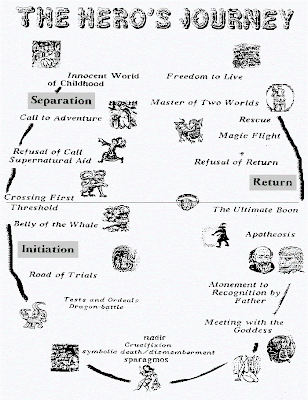Well anyway, he's an academic who wrote a rather influential book called The Hero with a Thousand Faces which basically describes the template found in stories since ancient times. And yes "template" is singular.
I always found it a fascinating notion that there was this underlying structure fundamental to storytelling, and Hollywood has certainly taken notice, but I was never quite able to wrap my head around Campbell's ideas. His map is a little...
...complicated.
Recently though I was Called to Adventure when a friend referred me to some articles written by Dan Harmon, the creator of the periodically outstanding show Community. I encourage you to read them yourself, if this stuff interests you, but basically his version of the Hero's Journey goes like this:
- . A character is in a zone of comfort,
- . But they want something.
- . They enter an unfamiliar situation,
- . Adapt to it,
- . Get what they wanted,
- . Pay a heavy price for it,
- . Then return to their familiar situation,
- . Having changed.
Okay, that I can understand.
After reading his stuff, I feel like I have a better handle on this whole "monomyth" idea, so here's my interpretation of three well-known films using Dan's model. I chose these specifically as wildly different genres, and we can nitpick whether or not I applied the model correctly, but hopefully you'll agree that these films very much share the same basic structure:
Refusal of the Call:
-Luke initially tells Obi Wan that he can't leave the farm (but then he finds it burnt to the ground along with his aunt and uncle).
-Dorothy is frightened about meeting the Wizard (although in her case this is after "crossing the threshold").
-Leo doesn't want any part of the scheme until Max convinces him that his drab existence is really no better than prison. (Max and Leo are sort of two opposing halves of a single hero.)
Tests, Allies, Enemies (this is Vogler's phrase. Campbell call's this stage "Road of Trials." Dan Harmon calls it "Search.")
In the first half of their adventure in the "special world," each of our heroes meets a collection of bizarre characters, as well as someone who will menace them later. At some point their resolve is also tested.
Atonement with the Father (aka "step 6: Take"):
-Luke sees Darth Vader, though he doesn't know [it was his sled].
-Dorothy forgives the Wizard and begs him to bring her home to Kansas in his balloon.
-Max and Leo are menaced by Franz Liebkind who is their play's "father."
George Lucas has in fact acknowledged being inspired by Joseph Campbell's work, but the truth is these primordial elements can be found in nearly everything you would call a story, from ancient myths to radio plays, videogames and sandwich commercials.
For more on story structure, listen to Jack Black in a wizard suit (by which I mean he's wearing a wizard suit, but you're welcome to wear one too, I guess):



No comments:
Post a Comment